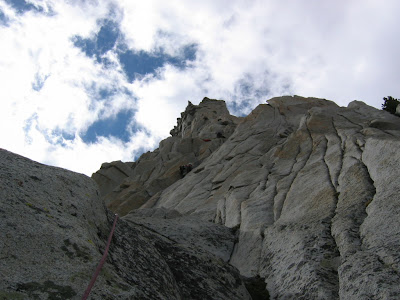AAI's International Programs Coordinator, Andy Bourne, decided to take his late summer vacation to the Eastern Sierra in September. He and local goofball Josh Wonner had a big ticklist they wanted to complete. Although they managed to get up a couple of Sierra alpine classics, the weather moved in after a couple of days and "forced" them to concentrate their efforts on the noble pursuit of bouldering and soaking in hot springs. It's a tough life indeed.
----------
From Andy:
We started out climbing Mt. Conness (12,590'), which has 3 main ridges to choose from. The East Ridge is the easiest, the North Ridge clocks in at Grade III 5.6, and the West Ridge is rated about the same as the North. Oddly enough, we decided to take the class 2 East Ridge for the ascent and then downclimbed the 5th class North Ridge for the descent.

Cresting the East Ridge, one is able to look down onto Tuolumne
Meadows, and the West Ridge and Southwest Face of Conness.

Scrambling up the East Ridge.

On the summit looking down our descent of the North Ridge.

5.6 downclimbing is great fun!

Looking back at the perfect granite
waves of the upper North Ridge.

And a foreshortened view of the entire North Ridge, almost a mile long.
Next up was the famed 3rd Pillar of Dana. Rated at 5.10b, this 5 pitch climb ascends some of the most amazing granite this side of the Bugaboos.

The short approach takes you from Tioga Pass,
up Glacier Canyon, past Mt. Dana.

The Dana Plateau lives up to it's name.
Here Andy wonders if they are going the right way.

The Dana Plateau abruptly drops off, forming the 3rd Pillar.

After a 4th class downclimb, we were at the base
of the route and found another party starting
the first pitch.

At the bottom it becomes obvious why this
route is a classic. It’s also a bit intimidating.

Here Andy struggles his way through the first 5.10 crux:
an insecure, flaring finger crack.

Josh finishes his lead below a giant flake where the party ahead
is perched. The last pitch can be seen above, where the handcrack
splits a series of roofs.

. . . And the reward - hot springs!

The hot springs of the Owens River valley, a climber's paradise.
The weather moved in later that day and we decided to spend the next few days bouldering at the Happy Boulders, appropriately named for their plethora of holds:




And along with the weather, the Sierra sky played its games with light:


------
To speak with someone about booking a trip in the Sierra for this winter (mountaineering courses, ice climbing, skiing) or for the summer 2008, please email us at info@aai.cc or give us a call at 360-671-1505. It's never too early to start planning for next year!

































